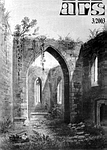
Časopis ARS 36 (2003) 3
Michal ČAJKA
Počiatky stredovekej sakrálnej architektúry na Liptove (Súčasný stav výskumu)[The Early Medieval Architecture in the Liptov Area (The Present State of Research)]
(Resumé)
The question of the origin and development of the Early Medieval architecture of the Liptov region has not been properly compiled yet by the Slovak experts. Therefore, author of this paper had but to opt for an interdisciplinary approach to evaluate it as well as to use results of not only The Archaeology but the Art History, too.
In the 19th Century, the Medieval architecture of Liptov was roughly examined by Š. N. Hýroš and V. Miskovszky in their documentary lists of monuments which can be found in the area and which offer a source of precious information about today's already derelict churches. V. Mencl was another researcher who dealt with the problem in the last century. He concentrated on the early architectonic expressions of Liptov religious architecture, which he linked to the Transient or Cistercian-Burgundian Gothic style. This style was supposed to be spread into the northern territory of Slovakia during the process of colonization. The results of the development of the religious architecture in Liptov were changed by many archaeological and monument care discoveries from the last third of the 20th Century.
In the 1980's, the archaeological excavations were made in the early Gothic church of St. Mary in Liptovská Mara and revealed remains of the oldest Romanesque church from the turn of the 11th Century.
It was built as a one-nave church with a rectangular presbytery and a tower, which was added later in the western part of the church. One of the most significant discoveries was a pair of stones with engraved crucifix, probably the one known as "lapis primarius", which was put into the foundations during the building's consecration. Because such a Christian custom is typical of the 13th Century, the church is considered to be one of the early examples of the Central European architecture. At that time, Liptovská Mara became an important Christian centre in the Liptov region and its social importance lasted in this geographical space throughout the Middle Ages.
Archaeological research helped better understand the history of many other churches in the region. The origin of St. Spirit's church in Komjatná was doubtfully dated back to the 12th Century by the author of its excavations. The oldest churches in Liptovský Mikuláš, Šoldov near Štrba, Sv. Štefan (St. Stephen) or Liptovská Anna, come from the second half of the 13th Century. Excavations of ruins of Liptov Castle did not rule out the existence of a castle chapel.
All things considered, a typical church of the Liptov region was a one-nave church with a rectangular presbytery, except the church in Komjatná, which had a polygonal presbytery and was built in the 14th Century. From all these churches, there is no evidence of an architectonic character left, which is why it is impossible for us to make any art historical analysis of the oldest buildings.